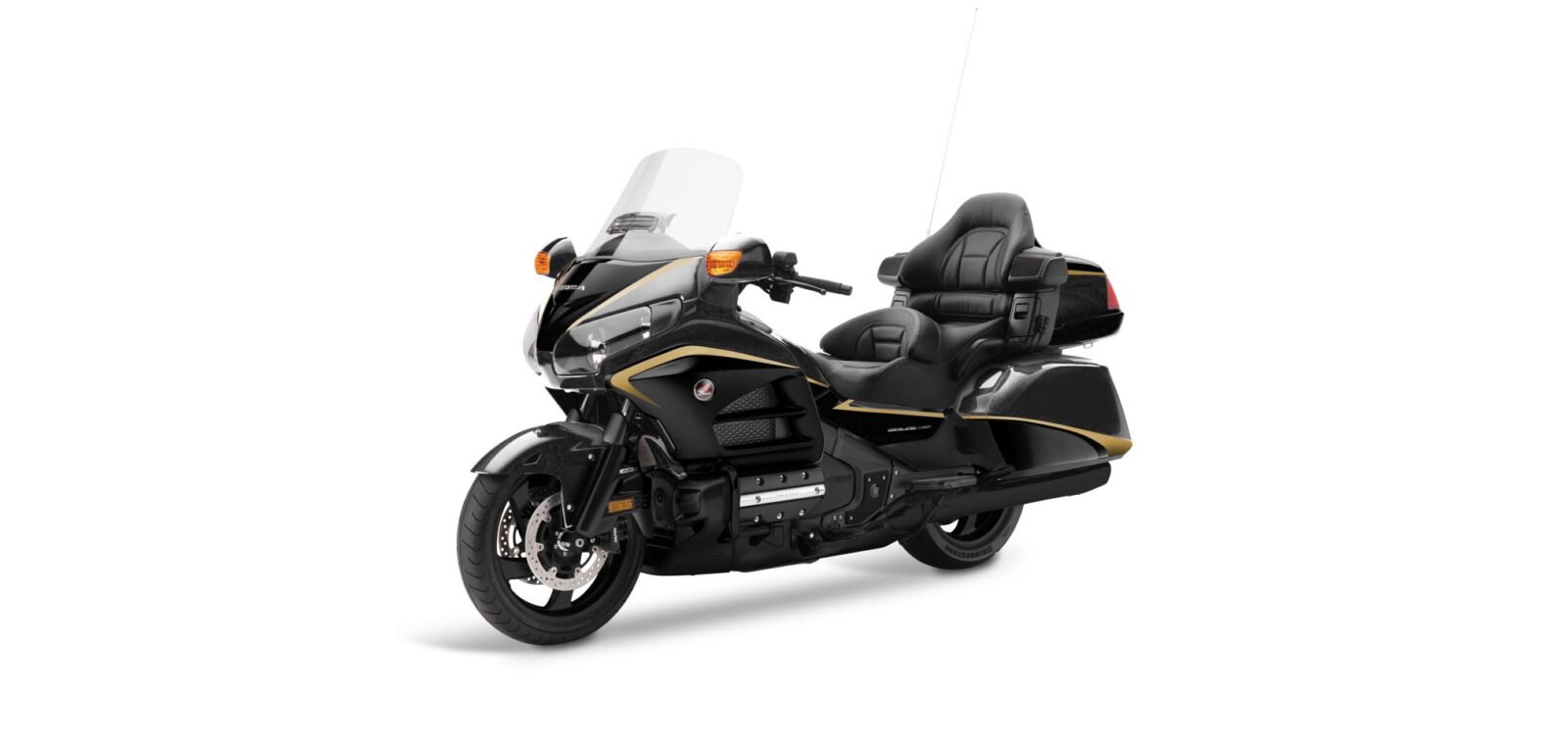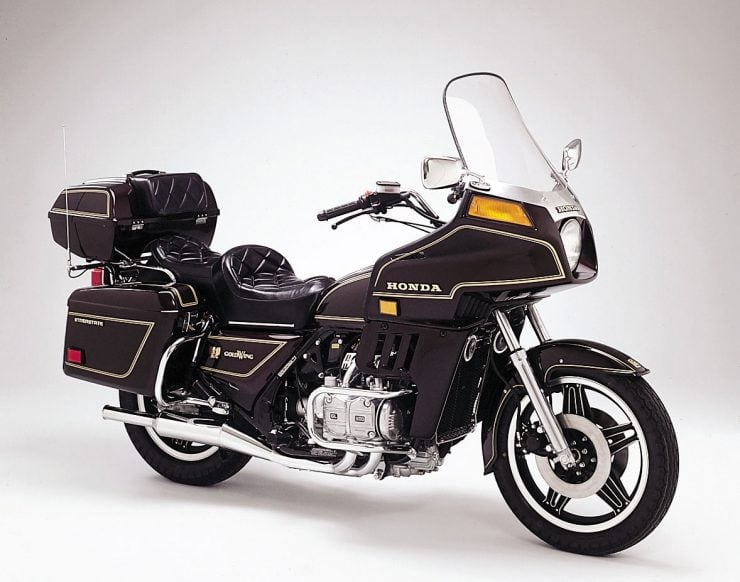Introduction
The Honda Gold Wing has been pretty much the archetypal grand touring motorcycle from its debut back in 1974. This is a motorcycle that Honda described as the “King of King motorcycles”, their own CB750 having already been given the title of “King of motorcycles”. That Honda got their concept right in the first place is evidenced by the fact that the Gold Wing, in its progressive evolutionary iterations, has been with us from 1974 to the present day with no signs of it being declared obsolete any time soon. It is to motorcycling what the big Lexus luxury car is to automobiles; and just as Lexus owners tend to be satisfied owners so Honda Gold Wing owners also tend to be happy with their choice of bike. Gold Wings have indeed earned their wings as comfortable and reliable. and let’s face it, none of us wants to have our bike break down in the middle of nowhere, especially if it’s raining or we are in the midst of bear country.
History
Honda had introduced their CB750 in1969 and it became clear very quickly that they had created a world beater, but even as Honda basked in the booming sales, rival Kawasaki unveiled their Z1 900cc superbike in 1972 and the CB750 was instantly overshadowed. Soichiro Honda realized that a new motorcycle was needed, and that there would be little point in engaging in an arms race with Kawasaki and the other Japanese makers. What was needed was not a faster more powerful motorcycle, but a new concept. Just as the Honda CB750 had pretty much invented a new category of motorcycle, the modern “superbike”, so the safest strategy for Honda was to do the same thing again; to target a new genre of motorcycle, hopefully one that others would not be easily able to compete with. Design work began on the new motorcycle concept in 1972, the same year as Kawasaki introduced the Z1.
M1 Prototype
The M1 was never intended to go into production; it was created to test a set of design concepts. Shoichiro Irimajiri, who had designed the 3 liter RA273E V12 Formula 1 race car engine and the five and six cylinder Honda motorcycle racing engines, was chosen to lead the design team. They broke the mold of past Honda designs and combined ideas a little similar to those used by BMW and Moto Guzzi yet significantly transformed. The engine capacity of the M1 was 1,470cc, double that of the CB750. Instead of a parallel twin or an in-line four they created a flat six horizontally opposed engine mounted longitudinally in the frame and mated it to a shaft drive, both firsts for a Honda motorcycle. The M1 was also liquid cooled, despite company founder Soichiro Honda not believing liquid cooling was necessary. This engine was not designed to be a Kawasaki Z1 beater however. The despite the engine giving the motorcycle a very low center of gravity the width of the engine precluded the bike from being laid over far enough for performance bike cornering; instead the emphasis was placed on providing a large dose of torque to go with amply sufficient power of 80hp @ 6,700rpm. This gave the M1 a top speed of around 140mph (220km/hr) making the bike almost as quick as a Jaguar XKE. The long engine made the riding position on the M1 prototype uncomfortable and so the design team decided to re-do the design with a shorter engine.
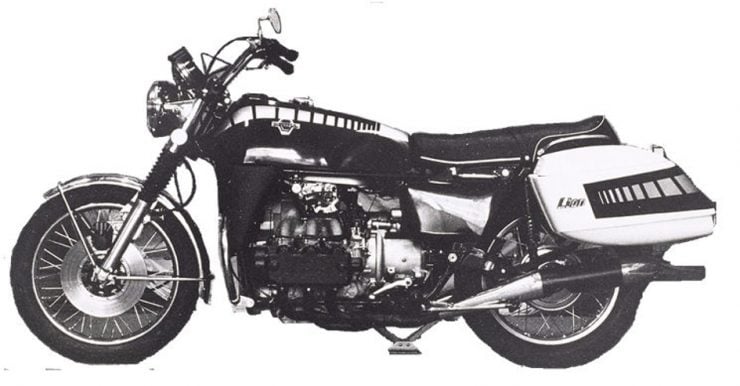
Project 371
Leadership of the design team for the new concept motorcycle was given to Toshio Nozue who had worked on the team that had created the highly successful CB750. The M1 project had shown the big six cylinder engine to be too big so he got his team to reduce the engine to a flat horizontally opposed four cylinder. This led to a SOHC engine of 999cc (61 cu. in.) capacity still producing 80bhp but at a higher 7,500rpm and 63lb/ft torque @5,500rpm. This engine was mated to a five speed gearbox mounted below the crankshaft, and also had a gear driven alternator that was counter rotating to the engine to eliminate the twisting effect on the bike such as one experiences on Moto Guzzi and BMW motorcycles of this time with their longitudinally mounted engines. This was the prototype that was morphed into the original Honda Gold Wing GL1000 of 1974.
Models and Specifications
Honda GL 1000
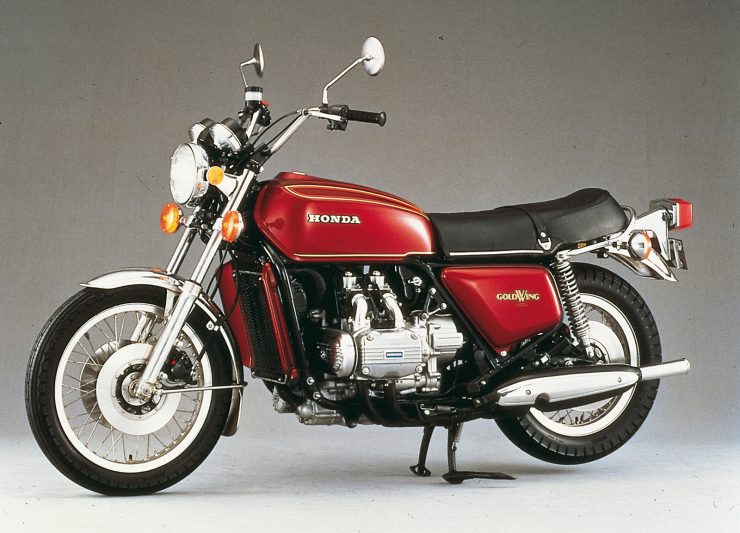
The first production Honda Gold Wing, the GL1000 design style was kept as minimalist and conventional as possible. The bike was named after the Honda logo, gold wings. Fitted with the engine and transmission that had been developed in the Project 371 the final production motorcycle featured a steel, full duplex cradle frame with the fuel tank mounted below the seat behind the unusually large side covers. It would have been too cumbersome to mount the fuel tank in the usual place ahead of the rider as this would have raised the center of gravity of the bike too high. Instead by mounting the tank below the seat the bike’s already low center of gravity created by the flat four engine was kept down low and this was of great help in making the bike’s considerable 650lb/295kg wet weight (584lb/265kg dry weight) manageable.
What looked like the fuel tank was actually a glove box and tool box compartment which contained a tool kit and kick starter lever just in case of failure of the electric starter or a flat battery; and the compartment also contained the top up tank for the radiator and easy access to the electrical fuses. The engine used single overhead camshafts on each bank of cylinders, and instead of noisy cam chains Honda used toothed belts to operate the cams. This has its pluses and minuses; the belts have to be changed at regular service intervals because if they are not changed and break the end result is a loud bang or two and an unhappy cloud of blue smoke from the engine mixed with a cloud of angry gloom from the rider. Wisely Honda made sure the belts were easily changeable by removing the front cover of the engine. Honda also fitted a cush drive at the rear of the crankshaft to cushion the engine from the drive train to ensure smoothness of power transmission.
The GL1000 was built to be a big touring bike although Honda had not yet figured out the seat, which was a typical Honda bike seat guaranteed to inflict a numb posterior on the rider after a few hours on the road. In reality Honda had most likely not yet fully figured out just what market this new concept bike would fit into. It was a big impressive bike built on the Japanese notion that Americans think that bigger is better. It was priced to be less expensive than its projected rivals; the Harley-Davidson Electra Glide of 1975 was USD$3,555; the BMW R90/6 was USD$3,395; and the Moto Guzzi 850-T was USD$2,699. Honda priced the Gold Wing GL1000 at USD$2,895 so it was not the cheapest but was temptingly affordable. It could have been expected to appeal to the police market in the United States also, but really Honda was floating an idea to see what would develop. Brakes of the Gold Wing GL1000 were dual discs on the 19” front wheel and a single disc on the 17” rear wheel.
The bike’s colors for its first year of production were Candy Antares Red and Candy Blue Green followed by Sulfur Yellow the following year. With its liquid cooled engine exhaling through a big efficient exhaust system, belt driven camshafts and shaft drive with cush drive the GL1000 was a quiet limousine of a motorcycle reminiscent of a Rolls-Royce except with two wheels. Probably the only potential disappointment for some was the quite firm suspension with 37mm front forks providing a firmly sprung 5.6” of travel whilst at the rear a similarly firm 3.4”. So, perhaps more like a 1920’s Rolls-Royce. In 1978 Honda revised some aspects of the GL1000 changing the engine cams to put more emphasis on mid-range power and reducing the carburettors to 31mm to enhance this. Acceleration was mildly reduced but not such that riders would be likely to really notice. The suspension was improved with better front forks with more travel and more comfort oriented shock absorbers. Honda also improved the brakes and replaced the spoked wheels with alloy Comcast ones which were better able to cope with the weight and momentum of the Gold Wing, especially when it was loaded up with accessories such as a front fairing, bags, and a passenger or two.
GL 1100, Interstate and Aspencade
In 1979 Honda introduced the new upgrade of the GL1000, the GL1100. For this model the engine capacity was increased to 1,085cc (66.2 cu. in.) which only added 1hp to the engine’s power bringing it to 81hp @ 7000rpm. Similarly there was a small increase in engine torque to 65lb/ft @5,500rpm. The engine’s cylinder heads were modified to improve combustion efficiency and the carburettors were reduced down to 30mm. The ignition was changed to an electronic system.
The intent of these changes was to improve the engine’s torque and mid-range performance. The wheelbase of the GL1100 was increased and the bike was given air suspension and an adjustable seat. Gear ratios were shortened to keep the engine in its most efficient combustion range for highway cruising speeds. In 1980, with the vast majority of GL1000 Gold Wings being sold in the United States Honda moved production from Japan to a new factory at Marysville, Ohio although the engines continued to be manufactured in Japan and shipped to Ohio for assembly into the locally produced bikes. In March 1980 Honda went to the next level and introduced a full production touring version of the Gold Wing called the Interstate.
The GL1100I Interstate featured a full front fairing, saddlebags and trunk. A host of optional extras were offered for the Interstate including a stereo sound system and in 1981 a 40-channel CB transceiver. This was a time when CB radio had become increasingly popular. The 1982 GL1100I model was also offered with an on-board air compressor to adjust the air suspension. The weight of the GL1100I increased significantly of course now being 686lb/311kg dry. In 1982 Honda introduced the GL1100A Aspencade which was a full featured super deluxe version. This bike was fitted with a larger more comfortable seat to ensure the rider experienced no rump numbing and many of the optional extras of the lesser models fitted as standard along with additional storage compartments. The 1982 version of the GL1100 Aspencade was fitted with dual internally ventilated disc brakes at the front and a single ventilated disc at the rear. For the 1983 model year the rear disc reverted to a standard non-ventilated type. Dry weight was now 707lb/321kg.
Honda GL1200, Interstate and Aspencade
By the early eighties the other Japanese motorcycle manufactures were of course seeing the success of the Gold Wing and consequently making and marketing their own full dress touring bikes to try to grab some of Honda’s share of the market. Yamaha, Kawasaki and Suzuki were all getting into the act and so Honda countered by increasing the engine capacity of the original GL1000 engine to 1,182cc (72.1 cu. in.) creating the new Gold Wing GL1200 and showing it at the 1984 Milan motorcycle show. Gearing of the new bike was a bit taller to cut down vibration and the engine’s carburettors were increased to Keihin 32mm CV (which were the same size as the carburettors used on the original GL1000). The engine also received hydraulic tappets for minimal maintenance and quietness whilst the clutch became hydraulically actuated. The size of the wheels was reduced with wheel and tire sizes of 130/90-16” 67H at the front and 150/90-15” 74H at the rear. The front suspension became air assisted and anti-dive with 5.5” travel whilst at the rear were air assisted shock absorbers with 4.1” travel. The frame was also re-designed with the result that despite the changes made the weight of the base model bike was 599lb/272kg. 1984 was to be the only production year for the basic bike however and it was phased out at the end of that year. In 1984 the Gold Wing GL1200I Interstate featured a more coordinated front fairing and large capacity luggage areas with two 38 liter saddle bags and a 63 liter trunk. The weight of the GL1200I was 697lb/316kg that year. This weight remained almost unchanged for 1985 and 1986 although there were some changes made to the GL1200I; in 1985 Honda decided that the taller gearing of the 1984 model had not been a good idea so they shortened it again. In 1986 the engines for the Gold Wing began production at Honda’s Anna, Ohio plant and were no longer imported from Japan. This made the GL1200 a fully “Made in the USA” motorcycle. 1985 saw Honda produce their GL1200L “Limited Edition” model which sold for a princely USD$10,000 and was painted in an equally regal gold livery. This model featured programed electronic fuel injection and was only made for one year. The top of the line 1986 Gold Wing was the GL1200A Aspencade and it had the same basic specifications as the GL1200I but with a digital dashboard display and a sound system with Dolby noise reduction which was upgraded in 1987 to a new Panasonic unit. The GL1200A Aspencade was of course a tad heavier than its Interstate sibling tipping the scales at 743lb/337kg.
Honda GL1500, Interstate and Aspencade
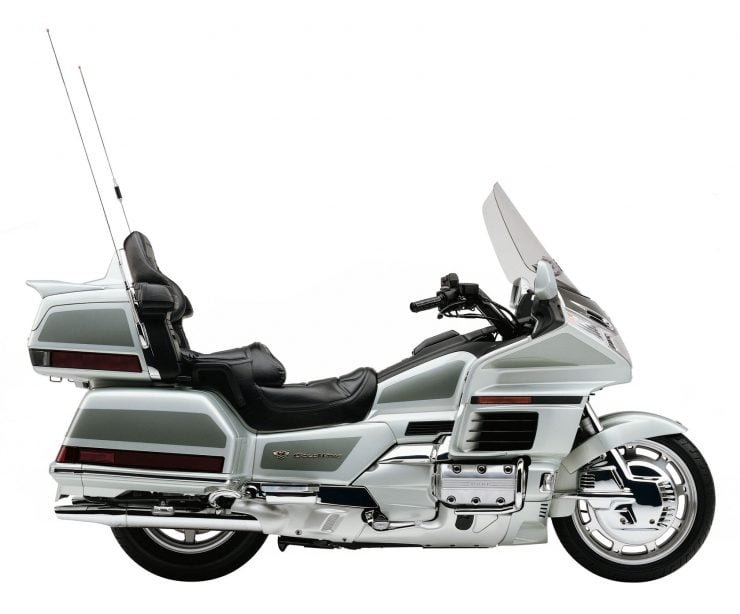
At this point of the Gold Wing’s development the original four cylinder horizontally opposed engine had reached the end of its possible development but to compete with the opposition Honda needed a new weapon in the arms race to make the most attractive long distance touring motorcycle. In a case of “everything old is new again” the development team went back to Shoichiro Irimajiri’s six cylinder M1 prototype engine and proceeded to shoehorn it into a GL1200 frame. Having made the engine fit the team got to work on refining it, reducing the number of carburettors from one per cylinder in conventional Honda style to just two 36 mm CV Keihins. The newly refined horizontally opposed six cylinder engine had a capacity of 1,520cc (93 cu.in.) and pushed out an entirely adequate 100hp @ 5,200rpm with 110lb/ft of torque @ 4000rpm. This was now a nice big low revving under stressed engine with all the natural smoothness of a six cylinder. The new GL1500 made its debut at the 1987 Cologne Motorcycle Show and it boasted features intended to send Yamaha, Suzuki and Kawasaki back to their drawing boards. The fairing wrapped around the bike in a coordinated way and the various luggage containers had central locking just like an automobile. The wheelbase was longer to accommodate the longer six cylinder engine. Suspension adjustment was by on-board air compressor. The model designations changed for this group of models. The Interstate was now the basic bike, the Aspencade the intermediate and the top of the line was the “SE” reminiscent of the earlier fuel injected Special Edition. These new series were getting heavier and so, rather than create a new gearbox, Honda provide a reverse capability for the first time by modifying the operation of the electric starter so it could be used to provide assisted reverse for the bike. The Aspencade was by now tipping the scales at 800lb/360kg. The GL1500I Interstate basic model was lighter than its optioned up siblings and did not have the reversing feature nor cruise control. The GL1500I ended production in 1997 when it was replaced by the GL1500CT “Valkyrie Tourer” which had a slightly higher performance engine, and that was replaced in 1999 by the GL1500CF “Valkyrie Interstate”. 1991 was the tenth anniversary of US made Gold Wings and the 500,000th motorcycle made at Honda’s Marysville, Ohio plant was a GL1500A Aspencade. This was repeated again just a few years later in 1996 when the millionth Honda rolled off the Marysville production line and again it was a GL1500A Aspencade. The GL1500A Aspencade was a luxurious motorcycle with cruise control, a quality audio system that was upgraded further in 1996 to the same unit that was fitted in the GL1500SE. The model received incremental upgrades over its production life particularly in styling and paintwork but also with engine, transmission and final drive upgrades in 1997. In 1995 to mark the 20th Anniversary of the Gold Wing Honda published a hard cover commemorative book “Gold Wing: The First 20 Years (Twentieth Anniversary Edition)” and all models were given special emblems with some modest style changes including a thinner and narrower seat which combined with suspension changes lowered the bike and provided a lower seat height which was helpful for shorter riders to manage the bike’s considerable mass. The GL1500SE was introduced in 1990 as the “15th Anniversary Special Edition” and then continued largely unchanged as the GL1500SE Special Edition from 1991 onwards. The features of both models included a vented windshield, an upgraded sound system, adjustable passenger floorboards and adjustable foot pegs with foot heaters for those long cold nights on the road, and additional lights, the whole package wrapped in a unique two-tone paint scheme highlighted with special insignia. The GL1500SE continued in production with progressive improvements and upgrades until the 25th Anniversary GL1500SE in 2000, the final year of production before the introduction of the next model. By this time the weight of the GL1500SE had quietly increased to 816lb/370kg dry.
Honda GL1800 F6B, F6C “Valkyrie”
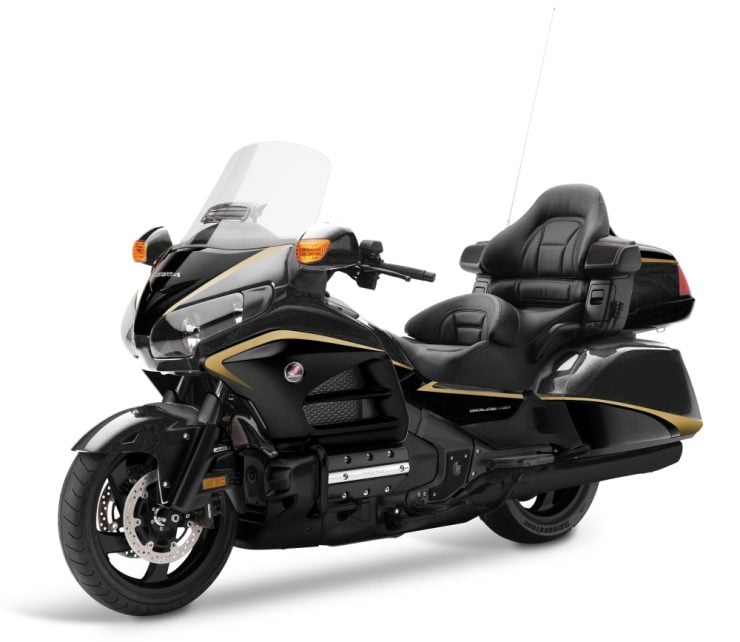
In 2001 Honda extensively re-designed the Gold Wing beginning with a new extruded aluminum frame that pruned a lot of weight off the bike. The new frame was a more simple design having 31 parts (which was about half the number of component parts of the old steel frame. The engine capacity was increased to 1,832cc (111.8 cu. in.) and with fuel injection as standard Shoichiro Irimajiri’s horizontally opposed six cylinder engine he’d created for the M1 prototype produced a healthy 117bhp and 108lb/ft of torque to go with it. With the lighter weight and increased engine power ABS braking was included as an option. Also in tune with this being a twenty-first century motorcycle in 2006 it was provided with an optional air-bag and optional GPS. The “comfort package” provided heated seats and handlebar grips to help ensure the rider experience was going to be as excellent as possible for long range motorcycle travel.
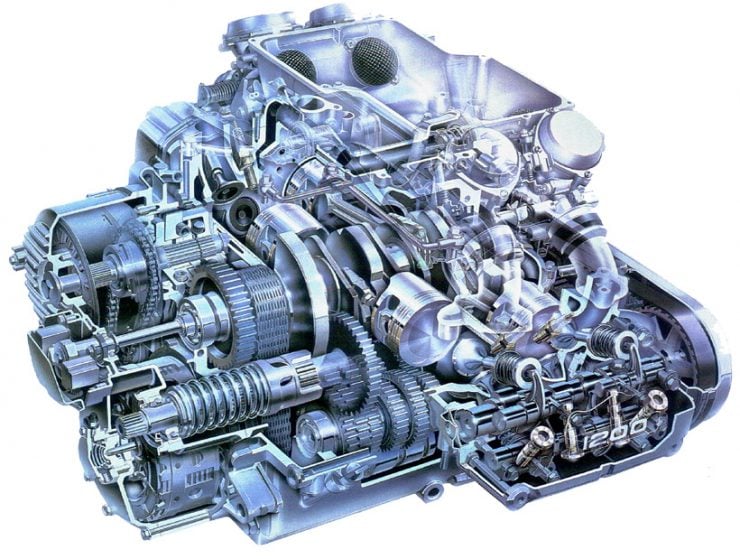
The base model GL1800 Valkyrie (called the F6C in international markets) picked up where the GL1500CT Valkyrie and GL1500CF Valkyrie Interstate left off. The Valkyrie was aimed at the buyer looking for a big stripped down performance motorcycle. In many respects it was the bike that some of Shoichiro Irimajiri’s original 1972 M1 design team had wanted to build; an eye popping, rubber burning, big muscle performance machine. The engine of the Valkyrie was quite different to that of the luxury touring Gold Wing models having solid valve lifters instead of the whisper quiet hydraulic ones and it had six carburettors, one for every cylinder, in true Honda performance bike tradition. The GL1800 Valkyrie was dropped from production in 2003 to be replaced with the limited edition GL1800 Valkyrie Rune with eye catching unique styling for 2004. The Valkyrie Rune was a bike that looked like something Luke Skywalker would be comfortable on and yet it managed to keep a rugged “muscle bike” look about it. It was a very clever no-nonsense space age muscle bike creation. 2011 was the time of a quantum shift for the Honda Gold Wing as Honda ceased US production in 2010 and there was no Gold Wing production for 2011. All manufacturing was transferred back to Japan and resumed there in 2012.
The GL1800 Gold Wing motorcycles produced in Japan from 2012-2013 onwards are sometimes referred to as the “Second Generation” of the GL1800 series (although the GL1800 series is itself the fifth generation Gold Wing since production started in 1974). With the resumption of manufacturing in Japan Honda decided to bring out a 2013 version of the Valkyrie which they called the Valkyrie Revival. This was a stripped down muscle bike and was first shown at the Tokyo Motorcycle Show in 2013. This stripped down GL1800 Gold Wing is a full 108lb lighter than the Gold Wing F6B and 170lb lighter than the fully equipped F6B Deluxe, so it has the character of a big powerful sports bike. This is a bike that will apply all that engine power and torque to doing rolling burnouts with which to impress friends and most anyone who sees the sheer power smoking that rear tire. In addition to the stripped down muscle bike, Valkyrie Revival, Honda’s model lineup for the Japanese made GL1800 line included the Gold Wing F6B and the Gold Wing F6B Deluxe. The Gold Wing F6B being a less expensive basic model Gold Wing with a lack of flashy chrome; it is a quite purposeful stripped down touring bike made to appeal to a new generation for whom chrome and flashy decorations are an anathema. This bike has come to be known as the Gold Wing “Bagger”. The F6B has a smaller windscreen, no rear trunk and consequently a smaller pillion passenger back rest. The F6B also lacks the power reversing feature. The look of the F6B has a definite “attitude” about it and it is cleverly designed to appeal to the cruising bike buyer who would eschew a Gold Wing with lots of chrome and bells and whistles. It is built to look and be no-nonsense and no doubt attracts buyers who might otherwise not look twice at a Gold Wing. The F6B is also 62lb lighter than the F6B Deluxe and it feels like a different bike to ride; lighter, livelier handling, easier to maneuver. It actually feels like it’s a hundred pounds lighter not just 62lb. It feels like an agile bike.
The Gold Wing GL1800 F6B Deluxe is a traditional Gold Wing in the style of the old “Interstate” and Aspencade models with the various bells and whistles including a pillion passenger backrest, surround-sound stereo, an airbag, heated seats, foot-warmers, and the power reversing feature. This is the GL1800 that appeals to riders who have loved the Gold Wing in its various iterations from decades past; people who just love the comfort and convenience. People who want a “real” Gold Wing. This is a complex motorcycle; would you believe it has more component parts than a Honda Accord automobile? As set up in the F6B Deluxe the 1,832cc SOHC flat six delivers 108hp and a thumping 125lb/ft of torque. The seat height is a comfortably low 29.1” and the fuel tank holds 6.6US gallons to help keep that almost two liter engine happily fed with gasoline for hour after hour of highway cruising. In fact you should get around 175 miles with a full load of two people and gear on before the low fuel warning light starts doing its job and about 200 miles before you find it’s time to start walking. The Gold Wing F6B Deluxe is available with four option packages to provide every comfort a demanding rider might want from great audio to C-ABS, navigation system, satellite radio, airbag etc. The big fairing and windscreen simply work as a rider will find out come their first “riding in the rain” experience. The bike is rock steady at highway speeds and the fairing and windscreen will keep you mostly dry whilst you are moving. This current iteration of Honda’s classic Gold Wing is a big heavy bike and it needs those triple disc brakes to make it stop. Being half the weight of some cars it tends to pull up more like an automobile. It is possible to push it hard but the Gold Wing F6B Deluxe is not really intended for that, it’s a big comfortable tourer and it has few rivals in that role. If you want a throw around rubber burning muscle bike then the Valkyrie is for you.
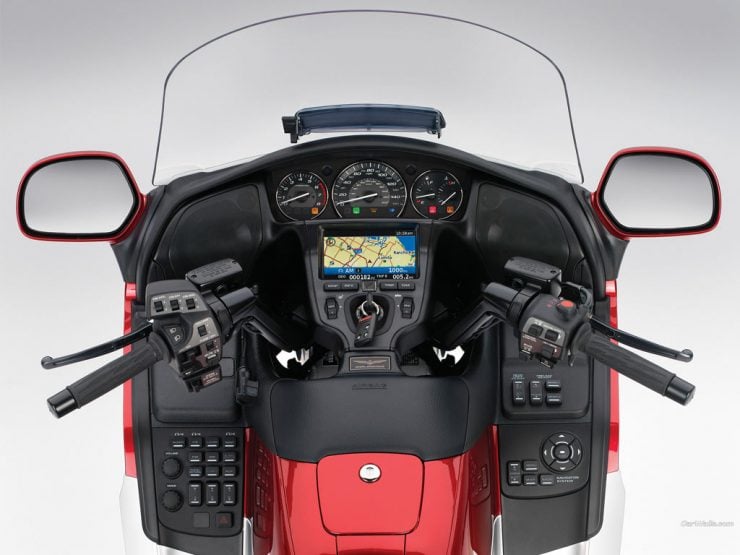
Conclusion
The Honda Gold Wing is arguably the “Gold Standard” of big touring bikes. It has its rivals from BMW and Harley-Davidson, and from some of the other Japanese makers. To manage a Gold Wing you need to have some riding experience under your belt on lighter and less powerful machines first. If you are comfortable managing a bike of this heft and are looking for a bike on which to travel from coast to coast then this is a bike on which to do it. Not many motorcycles can boast of still using an engine that was originally conceived way back in 1972, but Shoichiro Irimajiri was a brilliant engine designer and no doubt even he could not have foreseen just how successful his liquid-cooled SOHC flat six would be; nor how successful the bike that emerged from the M1 Prototype would become.

